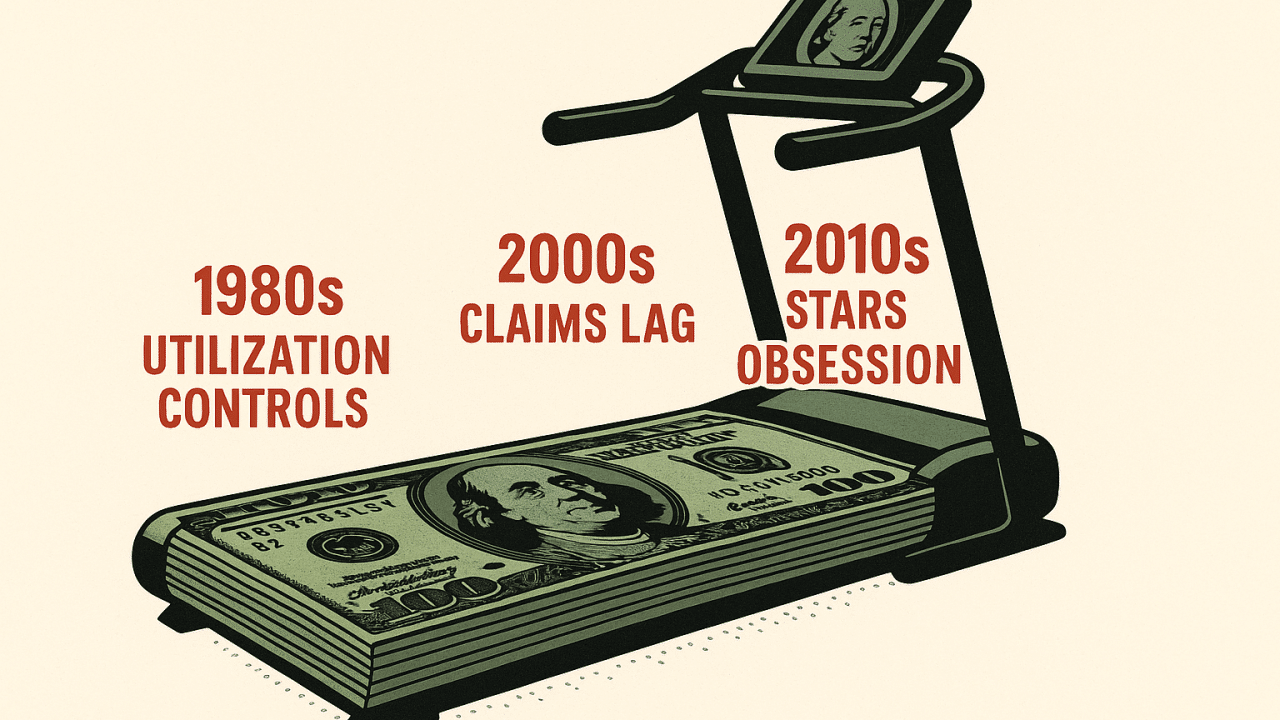
Part 2: The Demand-Side Treadmill: 1980s → Utilization Controls, 2000s → Claims Lag, 2010s → Stars Ratings Obsession
The history of population health management is not one of innovation. It’s the history of payers running on a treadmill, rationing, reacting, and reporting demand.
Each decade delivered a new version of the same treadmill: utilization controls in the 1980s, claims data in the 2000s, Stars Ratings obsession in the 2010s. The tools evolved, but the economics didn’t.
𝟭𝟵𝟴𝟬𝘀–𝟭𝟵𝟵𝟬𝘀: 𝗨𝘁𝗶𝗹𝗶𝘇𝗮𝘁𝗶𝗼𝗻 𝗖𝗼𝗻𝘁𝗿𝗼𝗹𝘀
The first treadmill was utilization management, prior authorization, denials, network restrictions. This was the HMO era. Costs were managed by blocking demand at the door.
It worked briefly. But the backlash was severe:
- Provider abrasion strained networks.
- Member dissatisfaction fueled turnover.
- Policy pushback forced health plans to ease restrictions.
Within a decade, medical spend was rising again. Utilization controls didn’t change health outcomes they just delayed them.
𝟮𝟬𝟬𝟬𝘀: 𝗖𝗹𝗮𝗶𝗺𝘀 𝗟𝗮𝗴 𝗮𝗻𝗱 𝗥𝗲𝗮𝗰𝘁𝗶𝘃𝗲 𝗖𝘆𝗰𝗹𝗲𝘀
The second treadmill was claims analytics. By the 2000s, payers invested heavily in data warehouses, predictive modeling, and care management platforms.
But the data itself was the problem. Claims carry a 180-day lag between care delivered and visibility. Risk was always identified too late and after the cost had already hit.
Billions were spent on care management programs designed to “intervene” on high-risk patients identified from lagging claims data. How anyone can intervene to prevent what has already happened is a joke in itself but alas here we are.
The results were predictable:
• Case managers burned out chasing patients who were already in crisis.
• Predictive models failed because their inputs were stale.
• Care management ROI collapsed. Deloitte and others have reported that the majority of care management interventions never achieve measurable savings at scale.
𝟮𝟬𝟭𝟬𝘀: 𝗦𝘁𝗮𝗿𝘀 𝗥𝗮𝘁𝗶𝗻𝗴𝘀 𝗢𝗯𝘀𝗲𝘀𝘀𝗶𝗼𝗻
The third treadmill came with the Affordable Care Act. The MLR 80/85 rule tied revenue to Stars Ratings, Quality Bonus Payments (QBP), and risk adjustment.
Payers went all in on gap closure programs, vendor networks, retrospective chart reviews, and HEDIS campaigns. Entire industries were built around boosting scores.
But this was still demand-side thinking, optimizing for rubrics written in Washington, not generating new supply of visibility. When CMS raised the bar in 2025, Stars ratings collapsed across the industry. Billions in infrastructure were exposed for what they were: a treadmill of scoring, not a foundation of economics.
𝗪𝗵𝘆 𝗢𝗽𝗲𝗿𝗮𝘁𝗶𝗼𝗻𝘀 𝗢𝘂𝘁𝗽𝗲𝗿𝗳𝗼𝗿𝗺 𝗖𝗹𝗶𝗻𝗶𝗰𝗮𝗹 𝗶𝗻 𝗣𝗼𝗽𝘂𝗹𝗮𝘁𝗶𝗼𝗻 𝗛𝗲𝗮𝗹𝘁𝗵
Here’s a controversial but necessary point: in population health, operational leaders often outperform clinical leaders.
Why? Because population health is economics before it is medicine.
Operations leaders understand Medical Loss Ratio (MLR), Health Benefit Ratio (HBR), Stars, risk adjustment, and utilization metrics.
Clinical leaders, by contrast, often struggle to connect interventions to system-wide margin impact.
This is why actuaries, operators, and finance executives have historically driven more measurable “success” in population health than nurses, physicians, or care managers. The treadmill has been designed to reward admin work and score chasing, not clinical outcomes.
It’s no coincidence that plans employ more people in Stars and Risk Adjustment departments than in population health nursing teams.
One day in the future we can dissect how that “reward the admin work” is working out in the current landscape.
𝗣𝗿𝗼𝗼𝗳 𝗣𝗼𝗶𝗻𝘁𝘀: 𝗙𝗮𝗶𝗹𝘂𝗿𝗲 𝗮𝘁 𝗦𝗰𝗮𝗹𝗲
After four decades of treadmill strategies, what’s the result?
- $4.5 trillion in U.S. health spend (CMS, 2022) — still rising.
- Commercial admin costs at 12–15% vs. Medicare’s ~2%.
- Medicare Advantage margins under pressure even as plans devote billions to Stars infrastructure.
- Medicaid managed care plans hitting HBR caps while outcomes for high-risk members remain flat.
- Care management ROI repeatedly shown to be minimal, often negative when scaled.
This is the definition of failure: treadmill economics that spend more to get less.
𝗧𝗵𝗲 𝗧𝗿𝗲𝗮𝗱𝗺𝗶𝗹𝗹 𝗘𝗳𝗳𝗲𝗰𝘁
Every generation of payer strategy, utilization suppression, claims lag, Stars obsession — has been sold as a breakthrough. But the treadmill has only sped up.
Short-term savings vanish.
Administrative overhead compounds.
Margins erode.
Outcomes stagnate.
This is demand-side economics in healthcare: rationing, reacting, and reporting.
What has never existed, until now, is a true supply-side engine that creates new inputs, not just new administrative burdens.
Part 2 of 10

MyRoad.io provides Targeted, Relevant, and Timely Data. Schedule a consultation to integrate into your sales funnel.

